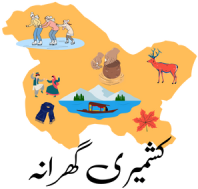Feran (Pheran)

Feran (also known as Pheran) is a traditional Kashmiri garment worn by both men and women. It is an integral part of Kashmiri culture and is widely worn in the Kashmir Valley, especially during the cold winter months. The feran is a long, loose-fitting outer robe made of wool, designed to provide warmth and protection against the harsh cold weather in the region.
Description[edit | edit source]
The feran is typically made from woolen fabric, often embroidered with intricate designs on the collar, sleeves, and chest area. It features a straight cut and is characterized by its loose fit, which allows for freedom of movement and provides ample space for layering. The garment is usually worn over other clothes and is secured with a waist belt or a cord. In some cases, it may have a simple V-shaped or round neckline. The fabric is often dyed in shades of brown, grey, or dark colors, reflecting the natural dyes available in Kashmir.
- Materials
Ferans are made primarily from wool, which is well-suited to the cold climate of Kashmir. In the past, the wool was handwoven, and the fabric was often adorned with embroidery and decorative patterns. Modern versions may also feature synthetic blends to reduce the weight and improve durability, but traditional woolen ferans are still highly valued.
- Design and Embroidery
The feran is often decorated with beautiful Kashmiri embroidery known as sozni, a form of needlework that involves intricate floral or geometric designs. The embroidery is typically done using silk thread in contrasting colors. The designs may be found along the hem, cuffs, collar, and neckline, adding to the elegance of the garment.
Cultural Significance[edit | edit source]
The feran holds significant cultural importance in Kashmir and is a symbol of the region's heritage. It is considered a practical yet elegant attire that is worn in both everyday life and during festivals or special occasions.
The feran is often associated with the cold winters of Kashmir, as it offers both insulation and comfort. Traditionally, it was worn by people of all ages and genders, though in contemporary times, variations of the feran have been designed for different age groups and fashion preferences.
In addition to its functionality, the feran is also seen as a marker of Kashmiri identity. The use of local wool, the unique embroidery, and the distinctive style make it a symbol of Kashmir’s craftsmanship and cultural heritage.
Modern Usage[edit | edit source]
While the feran was traditionally worn throughout the year, it is now most commonly seen during the colder months, especially from October to March. It is worn by both men and women, and modern variations may include different cuts, colors, and patterns to appeal to contemporary tastes.
The traditional feran, with its detailed hand embroidery, is still worn by many older generations and during special occasions. However, younger generations often prefer more modern, simplified versions of the garment, which may feature minimal or no embroidery.
The feran is also worn by tourists seeking to experience traditional Kashmiri culture, particularly during visits to the Kashmir Valley during winter.
Similar Garments[edit | edit source]
Similar garments to the Kashmiri feran exist in other regions of South Asia. For instance, the chapan (a Persian-influenced coat) is worn in various parts of Central Asia, while the pattu or jamawar shawl is often worn alongside the feran for added warmth.
See Also[edit | edit source]
External Links[edit | edit source]
- [Kashmiri Gharana](http://www.kashmirigharana.com)
